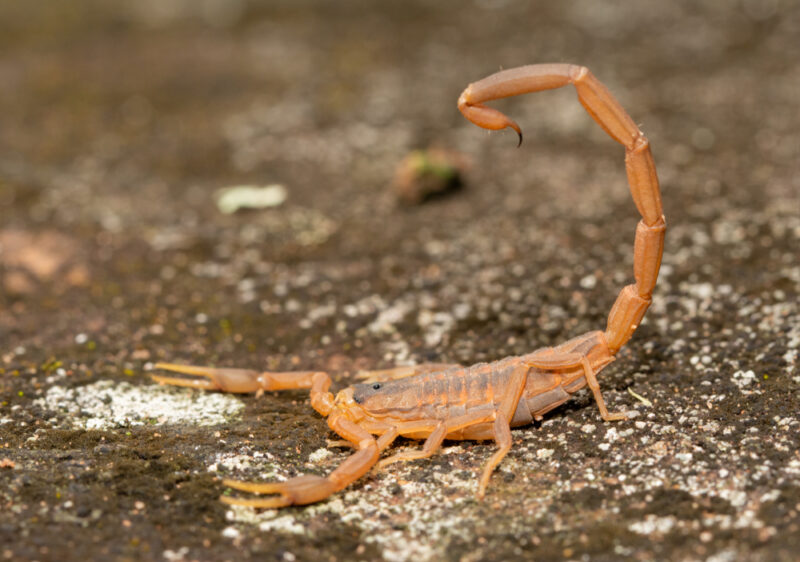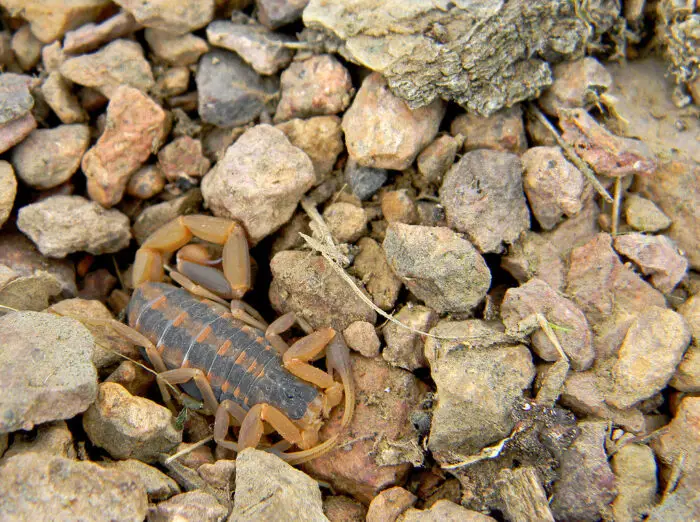Out of the seventy or so types of scorpions that live in North America, the state of Kansas only has a single scorpion species. That is the striped bark scorpion.
Unlike their cousins, the Arizona bark scorpions, striped bark scorpions have stings that are no more medically significant than a bee sting. However, all scorpion stings have the potential to cause severe allergic reactions such as anaphylactic shock. If you have blurred vision, muscle spasms, or difficulty breathing after experiencing a scorpion sting, seek immediate medical attention.

Common Striped Bark Scorpion (Centruroides vittatus)
Striped bark scorpions, which also go by the common names plains scorpion, wood scorpion, or stripe-backed scorpion, are Buthid Scorpions, just as the Arizona bark scorpion is. However, their sting is not nearly as dangerous as that of the Arizona bark scorpion. Common striped bark scorpions are the most common scorpions in the United States. Thousands of people are stung by them each year when they step on them with bare feet or come into accidental contact with them in some other manner.
These scorpions are distributed throughout Kansas. In fact, they are even fairly common in metro areas such as Manhattan and Kansas City.
Although the sting of a striped bark scorpion is no more medically significant than the sting of a wasp for most people, there is always the possibility of a severe allergic reaction. In fact, in 2014, a Kansas teenager from Haysville who had been playing frisbee golf, ended up spending 3 days in intensive care after being stung by a scorpion that had been hiding in his shoe. See the full article here.
Unlike northern scorpions and northern black hairy scorpions, which never venture far from their burrows, striped bark scorpions are wandering hunters. Like all bark scorpions, they are natural climbers. Besides living under rocks, they climb trees and fence posts and have no problem climbing the walls of your home. They actually have a negative geotaxis, or in other words, they prefer an upside-down orientation. See
Striped bark scorpions live in a variety of environments, such as woodland, grassland,0 and desert. During the day, they will take shelter in rock outcroppings, dark places, rocky areas, beneath loose bark or in piles of wood, etcetera.
Unfortunately, since bark scorpions are such good climbers, they also easily climb bed frames to take shelter under your covers. If you have a scorpion infestation problem, to get some peace of mind, you might place each of the legs of your bed in a glass jar. The idea being that glass is too slick for the scorpion to climb.
Like all scorpions, they are nocturnal hunters and will be under shelter until after sundown. What’s more, as all scorpions do, they have fluorescent compounds in their exoskeletons that make them glow under black light. If you are camping in an area where striped bark scorpions are active, it’s a good idea to go armed with an ultraviolet flashlight. Use the ultraviolet light to scan your campsite after dark.
The range of the striped back scorpion begins in the northern Mexico states of Chihuahua, Coahuila, Nuevo Leon, and Tamaulipas. It then extends northward up to the southern counties of Nebraska. Their range also extends longitudinally from the Sangre de Cristo mountains and Rio Grande of New Mexico in the west and the Missouri River and the Mississippi River in the east. The following U.S. states have populations of striped bark scorpions: Arkansas, Colorado, Kansas, Illinois, Louisiana, Missouri, Nebraska, New Mexico, Oklahoma, Florida, Georgia, and Texas.
In areas with colder wintertime temperatures, striped bark scorpions survive by tolerating limited freezing of their body tissue. These scorpions then hibernate through the winter months.

What do striped bark scorpions look like?
All scorpions look a little bit like tiny land-dwelling lobsters with some distinctions. Lobsters have 10 legs, while scorpions have 8, and of course, lobsters don’t have a bulbous venom-filled stinger on the end of their tail, while scorpions do.
Adult striped bark scorpions are up to 2 3/4″ long. An adult of this species is uniformly pale yellow in color, with the exception of two longitudinal dark brown stripes that run the length of its back and a dark triangle at the top of their heads.
Striped bark scorpion behavior
Striped bark scorpions Mate in the fall and also occasionally in spring or early summer. The mating process begins with the male engaging the female scorpion in an elaborate mating dance called the promenade a deux. At this time, the male maneuvers the female to a spot where he can deposit a sperm packet called a spermatophore for her reception.
The male must hold the female over the spermatophore long enough for her to receive it. Therefore, larger males successfully mate a larger percentage of the time. If the female accepts the male’s spermatophore, the pair join together and rub chelicera in the “kiss” stage. At this point, the female takes up the spermatophore. What follows is about an 8-month gestation, after which their offspring are born alive.
After the newborn northern scorpions free themselves from the birth membrane, they will climb up their mother’s walking legs and onto her back. The young scorpions ride there on their mother’s back in a grouped formation, only climbing down to feed on pellets that the female scorpions create for them when she feeds until they are sufficiently old to strike out on their own. This is generally after their first molt. See
Also see:
14 Wild Berries and 8 Edible Wild Plants in Kansas
Recent Posts
The only venomous snakes in Washington State are Northern Pacific Rattlesnakes. The Northern Pacific Rattlesnake (Crotalus oreganus oreganus) is a sub-species of the Western Rattlesnake. Anyone...
Skunks are not classified as true hibernators. But they go into a state of torpor when the weather gets cold. Skunks are light sleep hibernators, along with opossums, bears, and raccoons. ...

